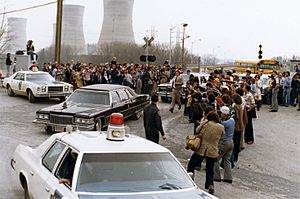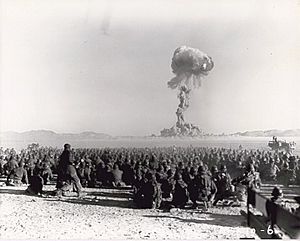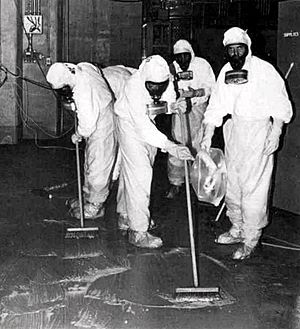Nuclear history of the United States facts for kids
The nuclear history of the United States is about how the U.S. has used and developed nuclear technology. This includes both peaceful uses, like making electricity, and military uses, like building weapons.
Contents
Key Moments in U.S. Nuclear History
Building the First Atomic Bombs
The U.S. nuclear story began with the Manhattan Project. This was a top-secret program during World War II to build the first atomic bombs. Even before these powerful weapons were finished, scientists working on the project had big discussions. They wondered if using such a weapon was the right thing to do.
Atomic Bombs and the Cold War
In August 1945, the U.S. used atomic bombs on the Japanese cities of Hiroshima and Nagasaki. These events marked the end of World War II. They also started a new period called the Cold War. During this time, the U.S. and the Soviet Union were in a tense standoff.
After the bombings, the U.S. began testing nuclear weapons. They also developed even more powerful bombs, like the Hydrogen bomb. Many people thought nuclear power would change the world. They imagined a future where nuclear energy would power everything. Glenn T. Seaborg, who led the United States Atomic Energy Commission, even dreamed of nuclear-powered shuttles to the moon!
Nuclear Power for Peace
In the 1950s, the U.S. also started developing nuclear power for peaceful uses. This idea was called "Atoms for Peace" by President Dwight D. Eisenhower. The goal was to use nuclear energy to help people, not just for war.

Building nuclear weapons was very expensive. This led to pressure to create a civilian nuclear power industry. The idea was that peaceful nuclear power could help justify the huge costs of the military program. The Atomic Energy Act of 1954 encouraged private companies to build nuclear reactors. This was a learning period, and some early experimental reactors had accidents.
The Cold War became very intense in the 1960s. A major event was the Cuban Missile Crisis in 1962. During this time, more countries started to get nuclear weapons. The U.S. also built many nuclear-powered things, like nuclear-powered ships and submarines.
Challenges and Changes in the 1970s and 1980s
On March 28, 1979, a serious nuclear accident happened. It was at the Three Mile Island Nuclear Generating Station in Pennsylvania. This was the first major accident at a civilian nuclear power plant in the U.S. After this event, many people became worried about nuclear safety. The phrase "China syndrome" became popular, referring to a severe meltdown.
This accident led to many anti-nuclear movements across the U.S. Because of changing costs, new rules, and public concern, many planned nuclear power projects were canceled. Over 100 orders for new reactors were dropped in the 1970s and 1980s. This even caused some companies to go bankrupt.
In the late 1980s, the Soviet Union began to reduce its nuclear weapons. This led to agreements like the Intermediate-Range Nuclear Forces Treaty (1987) and START I (1991). These treaties aimed to cut down the number of nuclear weapons.
After the Cold War
After the Cold War ended, the U.S. nuclear programs did not change much. Both civilian and military nuclear activities stayed at about the same level as in the 1980s.
Civilian Nuclear Power in the U.S.
The safety of nuclear power in the U.S. is overseen by the Nuclear Regulatory Commission (NRC). The NRC sets rules for all nuclear plants and materials. This includes everything except for government-controlled nuclear facilities and naval vessels.
The 1979 Three Mile Island accident was a very important event. It made people question how safe U.S. nuclear power was. Other events also caused concern. These included a fire at the Browns Ferry Nuclear Power Plant in 1975. Also, in 1976, three engineers from GE spoke out about safety worries. These events made the public less supportive of the nuclear industry.
A movement against nuclear power grew in the U.S. in the 1970s. One major protest happened in 1977 at the Seabrook Station Nuclear Power Plant. Over 1,400 activists were arrested there.
More recently, safety concerns have continued. In 2002, a large rust hole was found in a reactor at the Davis–Besse Nuclear Power Station. This was called the "closest brush with disaster" since Three Mile Island. In 2012, a group called the Union of Concerned Scientists reported issues. They found that radioactive leaks were a problem at almost 90% of all reactors.
After the Fukushima nuclear disaster in Japan in 2011, nuclear safety became a top concern. U.S. officials began to look more closely at safety rules. They wanted to make sure plants could handle things like power loss, floods, and earthquakes. New safety standards were put in place, which would take several years to fully implement.
Military Nuclear Power in the U.S.

Between 1940 and 1996, the U.S. spent trillions of dollars on nuclear weapons. This included building bombs, planes, rockets, and facilities. It also covered maintenance and waste management.
Since 1945, the U.S. has made over 70,000 nuclear warheads. This is more than all other nuclear weapon countries combined. Most U.S. nuclear tests before November 1962 were done above ground. After the Partial Test Ban Treaty, all testing moved underground. This was to stop nuclear fallout from spreading.
By 2006, over $1.2 billion had been paid to U.S. citizens. This was compensation for being exposed to nuclear dangers from the weapons program. Also, by 1998, the Marshall Islanders received $759 million. This was for their exposure to U.S. nuclear testing.
In 2010, the U.S. had an arsenal of 5,113 nuclear warheads. Many Cold War facilities have been closed down. On December 5, 2012, the U.S. conducted its 27th underground nuclear test since 1992. These are called "subcritical" tests. They do not create a nuclear explosion.
Images for kids



